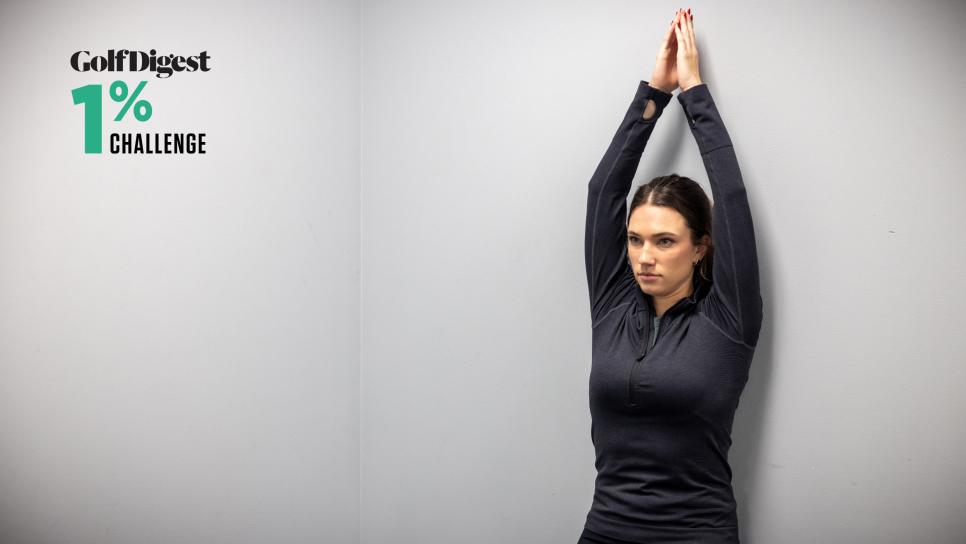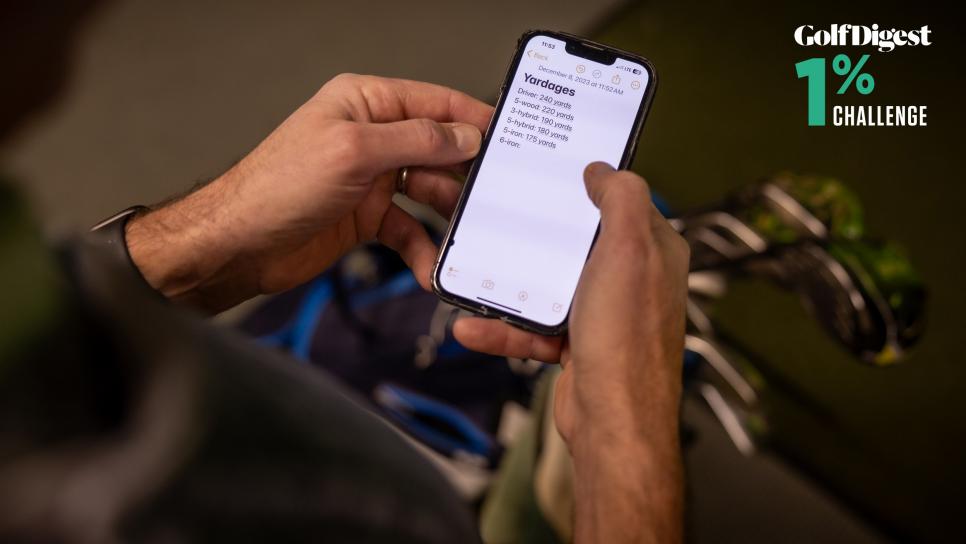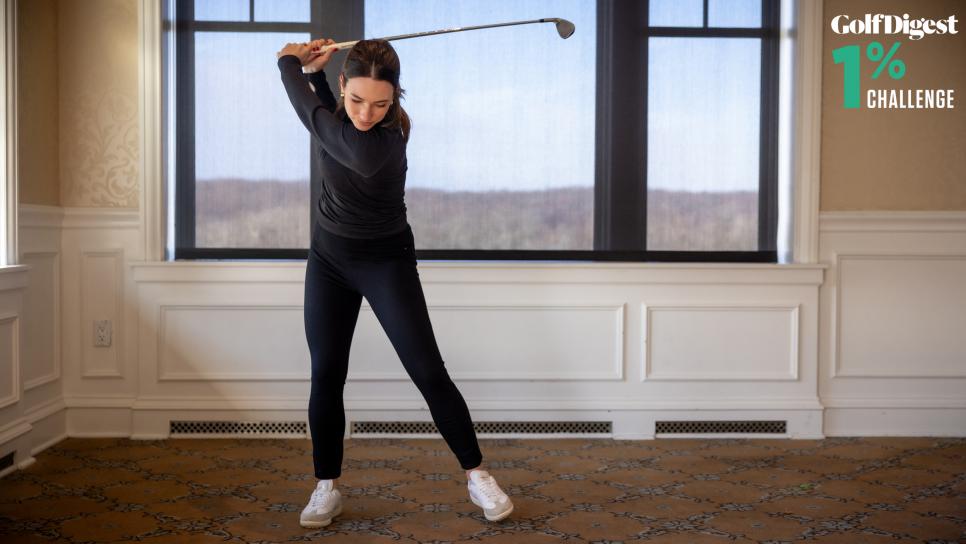1 Percent Challenge
1 Percent Challenge: This is the secret to lower stress—and scores

Editor’s Note: The Golf Digest 1 Percent Challenge will present a new challenge every weekday in January. Catch up on Week 1 or jump ahead to Week 3 here.
Golfers know the cliché that you need to stay in the present to play your best, but how do you do that? You might make a few pars or birdies, get ahead of yourself and have a blow-up hole … or two. Or worse, you get off to a poor start, become frustrated and compound your mistakes, ballooning your score. Of all of golf’s challenges, the struggle to find calmness and acceptance is one of the most difficult, but it is a key to lower scores.
The Solution: The good news is, you can develop an elite mental game by practicing mindfulness. Simply put, mindfulness is the state of being aware of all the various thoughts you’re having, accepting them and letting them go without judgement. You’re detaching yourself from all the clutter in the mind. One of the best ways to train mindfulness is to meditate, which studies have linked to lower levels of stress, anxiety and depression and improved sleep and mood.
Today: Meditate for 5-10 minutes. Many apps offer guided meditations that are great for beginners, but they’re not essential. Find a quiet spot, take a few deep breaths and close your eyes. Focus on your natural breathing and observe how your body is feeling. When your mind wanders (and it will, that’s normal!), slowly bring your attention back to the body. Don’t try to eliminate those thoughts, just observe them in a non-judgmental way.
And then … : Incorporate meditation into your daily routine, building up to longer sessions of up to 30 minutes if your schedule allows. At a minimum, aim for at least 10 minutes a day. Meditation is like weightlifting—though you’ll experience short-term stress relief, the largest benefit is in consistent practice, which will train your mind to be calmer and more present on the course.—Drew Powell
Day 9: A three-step test for your golf muscles

The Solution: Before calling a teaching pro or logging hours at the range, you need to assess how the limitations of your body are influencing your form. Not sure where to start? Golf Digest’s chief fitness advisor Ben Shear has created a simple three-step test you can take on your own to see if your body is holding you back from better golf.
Today: Shear’s test takes only a few minutes and requires nothing more than you and a sturdy wall. The precise movements are all outlined here, along with a specific way to determine if you pass or fail. Once you’ve taken the test and know where you stand, Shear explains the ways it might be influencing your game (a tight back, for instance, often leads to fat and thin shots).
And then . . . : Shear’s test also comes with specific exercises you can do to help address the issue, some taking a few minutes at home several times a week, and even a few stretches to consider right before you play. Even a little work on your body will help you make the swing you want more often— Ron Kaspriske
Day 8: The quick takeaway checkpoint that will fix your backswing

Whatever your body type, flexibility or skill level, you can learn to take the club away like a tour pro. Still, so many amateurs get the club off plane early in the swing, causing complicated compensations. They either roll the club to the inside early in the backswing before lifting their arms and coming over the top in transition, or they take the club way too far outside, forcing them to reroute to get the club back on plane. Consistency comes from simplicity and repeatability, and a clean takeaway can fix a lot of other problems in your swing.
The Solution: Most tour pros take the club away on plane. If you stop their swings when the shaft is parallel to the ground, the clubhead is either slightly in front (to the right) of their hands or directly through them. To fix an inside takeaway, you need to focus on proper sequencing and an earlier wrist set, as Butch Harmon describes. Allow the clubhead to move first, followed by the hands, arms and chest. Think hands in, clubhead out as you start the swing.
More from Golf Digest
Today: Butch Harmon has a simple drill to get you started on plane. Place a ball on the ground and set a club or alignment rod a foot directly behind the ball, on the target line. (You can do this drill indoors or outside; you don’t need to hit a ball.) Address the ball and allow the clubhead to “trace” the shaft on the ground as you take the club away, stopping when the shaft is parallel to the ground. Feel the clubhead moving first, followed by your bigger muscles. Trace the shaft 10 times.
And then … : Set a shaft behind the ball at the beginning of every practice session to ensure you’re starting the swing on plane and in the correct sequence. Video your swing from down the line and make sure that when the shaft is parallel to the ground, the clubhead is “in front” or through your hands.—Drew Powell
Day 7: Identify the gaps in your yardage
We tend to ascribe our assorted swing deficiencies to needing more time on the range, but very often the problem should be solved first with more time in the gym. When it comes to struggling with ball-striking, everything from poor stability, range of motion or muscle function can play a significant role.

Go to almost any golf course and look in the bags of those heading out to play. You’re likely to see a similar set make-up of 14 clubs. Driver, 3-wood, 5-wood, 3-hybrid, 4-iron through pitching wedge, two wedges and a putter. It’s basically the default setting of golf equipment. Instead, you should be thinking of your clubs as 14 friends you get to take along for a round of golf—you want them to be the best friends you can have. For many, that means a set make-up that varies, at times significantly so.
The Solution: Be open to unconventional thinking. Instead of two wedges you might need four or even five. Your iron set might not need to start until the 6-iron (in fact, many players will hit their 6-iron farther than their 5-iron because they tend to make better contact and produce a better launch condition). You might not even need 14 clubs. “The right number is what is playable,” says Chris Marchini, director of golf experience for Golf Galaxy. “I once sent a regular customer home with a set of 12 clubs and when he asked me why, I told him to go play and see if he noticed any gaps in his distances. The only call I got from him was to say thank you.”
Today: Play an imaginary round in your head at the course you play most and keep track of the clubs you typically hit. Also note times where perhaps you are in between clubs or ones you typically hit poorly. This will help identify the clubs you absolutely need to keep in your bag and ones that could potentially be on the trade or even chopping block.
And then . . . : Continue to do that when you next play, keeping track for a good five rounds to get a good sense of what clubs you do and do not use and how well you hit them. Employing shot-tracking devices such as Arccos is particularly helpful in this endeavor. Odds are you will find at least one, if not more, bad gaps that you can address that will put you 1-up at the bag drop the next time you play.—E. Michael Johnson
Day 6: Learn a new golf move in slow motion

It can be really hard for amateurs—and even pros—to make the moves they want in their golf swing while swinging at full speed. This makes it hard to implement real changes and improve.
Solution: Do what a lot of pros do: Rehearse the move you want to make in slow motion. If there’s a change you’ve been trying to make, set up with a club in your yard or in a room in your house with high enough ceilings and make the move over and over again, painfully slowly.
Today: You can do this in the summer, in the winter, in your living room, in your backyard, anywhere, any time. All you need is a club. Start today by doing 10 swings in slow motion, focusing on areas of your swing that you know need work. It can be helpful to do this near a mirror to make sure you’re on the right track.
And then...: Increase the number of swings you’re doing, so that you’re doing 50, then 100 per week. As you get more comfortable, increase the speed. Soon, that move that felt impossible at full speed will become part of your swing.—Keely Levins
More on the 1 Percent Challenge

Look, every golfer has big goals—30 more yards, 15 fewer pounds, tighter lines and better scores. We're not here to tell you those goals are out of reach. The problem with most New Year’s resolutions, though, is they start you at the foot of a mountain without a clear map to the top.
The Golf Digest 1 Percent Challenge, meanwhile, is meant to be both ambitious and achievable. None of the daily individual tasks will be so arduous that you'll need much time to cross them off your list. These are the type of modest improvements intended to make you just 1 better percent than you were the day before. But they’re also meant to provide you with a new skill that over time, can make a meaningful difference in your game.
The way it works is simple: Our team of expert editors in golf instruction, equipment and fitness have devised 23 challenges for each weekday in January that can be completed at home with minimal equipment. Things like checking your posture at address in the mirror, identifying yardage gaps in your club setup and testing the strength of your golf muscles. All of these challenges will have immediate value. But each challenge also comes with a suggested follow-up task that can lead to better habits, and ultimately, better performance.
It is the perfect way to get ready for the next golf season, even if you live somewhere where "real" golf is still months away. The more you follow along, the better your headstart on everyone else. —Sam Weinman